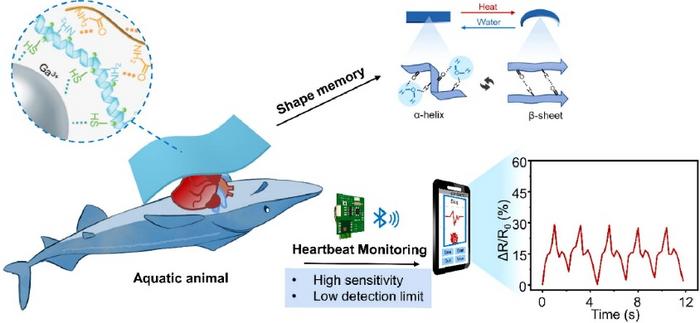In recent weeks, a groundbreaking innovation has emerged in the field of wearable electronics aimed at monitoring marine inhabitants’ health. Researchers publishing in the prestigious journal Engineering have developed a hybrid keratin (KE) hydrogel combined with eutectic gallium-indium (EGaIn) liquid metal, creating a new approach that not only enhances the functionality of wearable devices but also addresses significant limitations of existing technologies. This development holds tremendous promise in enhancing our understanding of marine ecosystems and improving the monitoring of aquatic life.
It has long been understood that monitoring the health and migration patterns of marine organisms is vital for maintaining ecological stability, advancing climate change research, and protecting public health. However, the task of developing effective sensors that can operate within the complexities of marine environments poses numerous challenges. Traditional hydrogels employed in smart sensor technologies typically face issues related to low conductivity, inadequate mechanical strength, and poor self-recovery capabilities, thus limiting their application in real-world marine settings.
The research team has ingeniously merged keratin, a protein derived from feathers and wool that is known for its biocompatibility, with liquid metal to produce what is referred to as keratin liquid metal (KELM) hydrogel. By dispersing liquid metal into a 5% solution of KE, they facilitated a chemical reaction that promotes both stability and enhanced functionality, achieved through processes like ultrasonication and subsequent polymerization. This innovative marriage of materials not only improves the hydrogel’s characteristics but also broadens its potential applications in biocompatible wearable technology.
Remarkably, the KELM hydrogel displays extraordinary mechanical properties, highlighted by its impressive tensile strength measured at 166 kPa and an astonishing stretchability of 2600%. Furthermore, its electrical conductivity reaches a significant value of 6.84 S/m, pairing this feature with a gauge factor of 7.03—signifying an ability to detect strain with unparalleled sensitivity. These traits make the KELM hydrogel an excellent candidate for long-term monitoring purposes, particularly in the field of marine biology, where real-time data can aid in the preservation of aquatic life.
A key consideration for any device intended for biomedical applications is its biocompatibility. Extensive tests performed on human epidermal keratinocyte (HACAT) cell lines established that the KELM hydrogel exhibits minimal cytotoxicity and superior cell compatibility. Notably, the hydrogel has demonstrated impressive adhesion not just to human skin but also to the skin of various aquatic organisms, proving it to be a feasible solution for monitoring without causing damage or adverse reactions in these living beings.
The practical application of the KELM hydrogel-based sensors has already yielded promising results. The devices were successfully employed to monitor heartbeat patterns in both invertebrate and vertebrate marine animals, such as scallops, sturgeons, and giant salamanders, highlighting their versatility. This real-time tracking can lead to immediate data transmission wireless, thus enabling researchers to gather critical insights into the health statuses of these animals. The ability to detect slight fluctuations in heartbeat patterns offers valuable information, thereby serving as a non-invasive method to gauge aquatic organisms’ well-being.
However, the researchers are cognizant of some ethical implications. The current methods employed to measure heart rates in vertebrate aquatic animals raise concerns regarding their invasiveness potentially disrupting normal physiological states. Addressing these issues is essential as the research team contemplates more refined methodologies. The future direction of their work includes developing minimally invasive installation techniques and enhancing the recovery environment post-sensor application to ensure it does not impede the natural behavior of these animals.
Beyond its specific application to marine biology, this research opens a dialogue about the broader implications of the KELM hydrogel in flexible electronics and medical monitoring devices. As we navigate an increasingly interconnected world where technology and biology intersect, this innovative material demonstrates the potential for wearable sensors to adapt and thrive in diverse environments. It serves not just as a method for health monitoring, but as a paradigm shift in how we perceive our relationship with technology, particularly concerning biocompatibility in wearable devices.
This study’s publication is not only a significant contribution to the field of engineering but also acts as a springboard for advancements in materials science and wearable technology. It underscores the importance of interdisciplinary collaboration in facing some of the world’s pressing challenges, including the effects of climate change on marine ecosystems and the need for more effective surveillance of aquatic populations.
The authors, Lidong Wu, Jinxue Zhao, Yuanxin Li, Haiyang Qin, Xuejing Zhai, Peiyi Li, Yang Li, Yingnan Liu, Ningyue Chen, and Yuan Li, have paved the way for further research that could combine more advanced materials with wearable technology, making strides towards sustainable solutions that balance technological innovation with ecological stewardship.
Their study titled "Biocompatible Protein/Liquid Metal Hydrogel-Enabled Wearable Electronics for Monitoring Marine Inhabitants’ Health" is poised to inspire future research, increasing awareness of marine conservation efforts and the critical role technology can play in this domain. As researchers move forward, it will be exciting to see how this innovative approach evolves to meet the ongoing challenges posed by both scientific inquiry and practical application.
In conclusion, this advance in hydrogel technology represents a significant leap forward in wearable electronics, with far-reaching implications for our understanding of marine health and, by extension, environmental health. It is an eloquent reminder that with innovative thinking and collaborative effort, we can develop more effective tools for understanding and protecting our planet’s biodiversity.
Subject of Research: Hybrid keratin hydrogel integrated with liquid metal for monitoring marine health
Article Title: Biocompatible Protein/Liquid Metal Hydrogel-Enabled Wearable Electronics for Monitoring Marine Inhabitants’ Health
News Publication Date: 13-Jan-2025
Web References: DOI link
References: Not applicable
Image Credits: Lidong Wu et al.
Keywords: Biocompatible, wearable sensors, marine health monitoring, hydrogel technology, liquid metal integration




